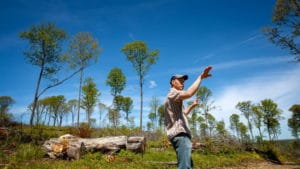Stability in Diversity: A Case Study of Birds in Sugarbushes

Aaron Wightman, operations manager at the Arnot Research Sugarbush, tours an area of Arnot Forest that has been managed to allow new tree growth.
Jason Koski / Cornell University
In an ecosystem, diversity means stability. When assessing the health of a natural space, one looks for diversity of species, diversity of ages within those species, balance between living and non living resources, and diversity between plant and animals. More and more research points to diversity in agricultural landscapes as a tool to create productive and sustainable food systems. This idea of promoting natural diversity within agricultural systems is demonstrated in Audobond Vermonts’s “Bird-Friendly Maple Project”. The project, which has been running since 2014, looks at new ways to manage sugar-bushes, or forests raised to produce maple products. It turns out that birds and maple production depend on the same thing: a healthy, diversified forest.
For birds, a monoculture of maple trees doesn’t provide habitats for tree specific bird species. A maple monoculture lacking a conifer component is unlikely to have species like blue-headed vireo, blackburnian warbler and sharp-shinned hawk. Besides habitats, Maple monocultures are missing food sources critical for migrating birds. Without fruiting trees and shrubs birds lack the fuel necessary to migrate long distances.
While it makes sense that bird species would thrive in a more diverse woodland, understanding how diversity promotes maple production is perhaps less intuitive. A University of Vermont Study found that sugarbushes with 25% non-maple trees experienced shorter and less intense insect outbreaks. Diversity is a key component of integrated pest management in any agro-ecological system. Varied habitats encourage beneficial species, natural enemies of pests, and offer general stability within the ecosystem.
Just as increased species diversity creates stability in sugar-bushes, increased stakeholder diversity creates positive change in the food system. Increasing the number and diversity of stakeholders is a tactic often used to bring about change.
“Conservation of anything — birds, habitat, anything — requires an all-hands-on-deck approach,” conservation biologist Steve Hagenbuch, who heads up Audubon Vermont’s Bird-Friendly Maple Project, told the Cornell Chronicle. “We can’t rely on protected areas, or even the goodwill of people interested in wildlife. We need to integrate [bird conservation] into our businesses, create financial incentives and encourage people to think about the role that their land management has in conservation.”
With this thought in mind, the Cornell Lab of Ornithology is partnering with the Cornell Maple Program to develop bird-friendly sugar-bush management strategies. The collaboration will echo Audobond Vermonts’s project, with hopes to bring about both crop and bird health and sustainability. Bringing together the two large Cornell organizations multiplies the positive effects of each and will hopefully create a lasting positive impact on both bird populations and maple production in the area.
Read more about this exciting project in the spring 2019 issue of Living Bird magazine, produced by the Cornell Lab of Ornithology.

